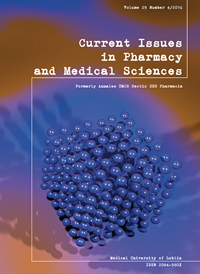Status of rats myocardium under subchronic mercury exposure and its pharmacological correction
DOI:
https://doi.org/10.1515/cipms-2016-0035Keywords:
myocardium, morphometry, salts of heavy metals, mercury, mercury (II) chloride, micromercurialism, ultramicroscopy, histochemistry, Unithiolum, QuercetinumAbstract
The article is devoted to the characteristics of the myocardium restructuring under the influence of 0.01 LD50 mercury (II) chloride, in rats, under subchronic exposure, and the correction of the detected changes. In the work, the structural and metabolic reorganization of myocardium was studied by way of general histological, histochemical and electron microscopic techniques. Herein, administration of Unithiolum reduces the severity of reactions to toxic effects of mercury salts: decreases the intensity of inflammation in the myocardium, improves microcirculation, connective tissue and mitochondrial membranes status and reduces cardiomyocytes apoptosis. Quercetinum has a normalizing effect on the myocardium structure, reduces energy imbalance in the myocardium, and stabilizes mitochondrial membranes. Both Unithiolum and Quercetinum promote intracellular ultrastructures recovery in cardiac myocytes and in endothelial cells, and enhance the regeneration of myofibrils.References
1. Aaseth J. et al.: Chelation in metal intoxication-Principles and paradigms. J Trace Elem Med Biol., 31, 260-266, 2015.
2. Avtandilov G.G. (1990): Medical morphometry. Guide. Medicine. (in Russian)
3. Ballmann C. et al.: Histological and biochemical outcomes of cardiac pathology in mdx mice with dietary quercetin enrichment. Exp Physiol, 100, 12-22, 2015.
4. Bernhoft R.A.: Mercury toxicity and treatment: a review of the literature. J Environ Public Health,. 2012, 2012.
5. Busch J. et al.: The heavy metals cadmium, lead and mercury in raw materials of animal origin: evaluation of data from practice. Pharm Bio Sci Notes, 2015, 150-165, 2015.
6. Cao Y. et al.: Chelation therapy in intoxications with mercury, lead and copper. J Trace Elem Med Biol., 31, 188-192, 2015.
7. Dziegiel P. et al.: Metallothioneins: Structure and Functions. Adv Anat Embryol Cell Biol, 218, 1-117, 2016.
8. Figueredo F.G. et al.: Cytoprotective Effect of Lygodium venustum Sw. (Lygodiaceae) against Mercurium Chloride Toxicity. Scientifica (Cairo). 2016, 4154265, 2016.
9. Foras L.D.: Quercetin in treatment cardiovascular. The radical Research., 39, 2005.
10. Graham I. et al.: Fourth joint task force of European society of cardiology and other societies on cardiovascular disease prevention in clinical practice (constituted by representatives of nine societies and by invited experts). European guidelines on cardiovascular disease prevention in clinical practice: full text. Fourth Joint Task Force of the European Society of Cardiology and other societies on cardiovascular disease prevention in clinical practice (constituted by representatives of nine societies and by invited experts). Eur J Cardiovasc Prev Rehabil., 14, 2, S1-113, 2007.
11. Jain A.K., Mehra N.K., Swarnakar N.K.: Role of Antioxidants for the Treatment of Cardiovascular Diseases: Challenges and Opportunities. Curr Pharm Des., 21(30), 4441-4455, 2015.
12. Kaminsky R. et al.: A study of impact of mercury chloride on myocardium in experiment. Georgian Med News., 251, 64-70, 2016.
13. Kim K.H. et al.: A review on the distribution of Hg in the environment and its human health impacts. J Hazard Mater, 306, 376-385, 2016.
14. Pierce E. (1962). Histochemistry theoretical and applied. M Moscow: Univ. foreign. Literature.
15. Rafati-Rahimzadeh M. et al.: Current approaches of the management of mercury poisoning: need of the hour. Daru, 22, 46, 2014.
16. Sokurenko L.M. et al.: Mildronate protects neuroblasts against toxic influence of mercuric chloride in cell culture. Neurophysiology, 46(3), 271-273, 2014.
Downloads
Published
Issue
Section
License
Copyright (c) 2017 Authors

This work is licensed under a Creative Commons Attribution-NonCommercial-NoDerivatives 3.0 Unported License.


